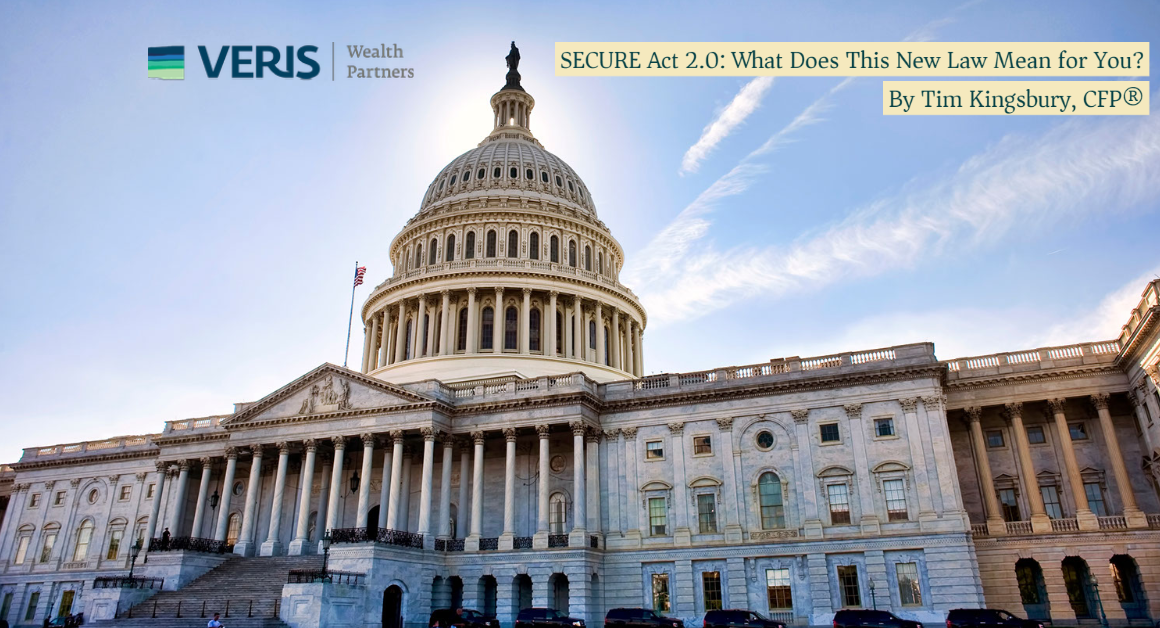SECURE Act 2.0: What Does this New Law Mean For You?
By Tim Kingsbury, CERTIFIED FINANCIAL PLANNER™
Intended to persuade more Americans to begin saving for retirement, the Securing a Strong Retirement Act, otherwise known as SECURE Act 2.0, was passed into law as part of the omnibus spending package signed by President Biden on December 23rd of 2022.¹ This bipartisan legislation will change hundreds of rules related to 401(k), 403(b), traditional and Roth IRAs and other types of retirement accounts.
These rules were already complex, and SECURE Act 2.0 adds a number of new considerations that Americans must make when planning for the future.² How might this new law impact you or your family? Here are five provisions in SECURE 2.0 that you might want to be aware of:
1. The Required Minimum Distribution (RMD) Age is Changing
Starting on 1/1/2023, the age that Americans must begin taking required minimum distributions (RMDs) from their retirement accounts went up from 72 to 73 years of age, according to Section 107 of the SECURE act.³ You may also want to be aware that SECURE 2.0 will raise the RMD age again in just a few years. In 2033 the RMD age will increase from 73 up to 75 years of age.⁴
When Americans reach the RMD age, the IRS begins requiring us to withdraw a specific minimum amount from our IRA, SIMPLE IRA, SEP IRA, and other types of retirement plan accounts every year.⁵ Now, if you are 73 years of age or older and do not withdraw the minimum, you are at risk of having to pay a tax penalty. The law is so new that, as of the time this was written, the IRS worksheet you can use to determine your RMD still links to 2022 data, but we believe they should update it soon. Consult your tax professional for the latest information.
2. New Option to Rollover a 529 Plan to a Roth IRA in Some Circumstances
A 529 account is a savings plan that many families use to save for qualified educational expenses, including tuition for colleges and universities. Many parents, grandparents, and other family members often wonder what happens to the money if the student they are saving for decides not to go to college? SECURE 2.0 now offers a new option for certain 529 plan holders that find themselves in that situation.
According to Section 126 of SECURE 2.0, beginning in 2024, if you have held that 529 plan for at least 15 years and meet the new law’s other requirements, you will have the option to rollover money saved in a 529 plan account into a Roth IRA set up in the name of the 529 plan beneficiary.
The beneficiary must have compensation income or earned income in excess of the contribution amount. Those Roth contributions must be within the annual contribution limit and a $35,000 lifetime cap is in place on what can be rolled into the Roth IRA.⁶
3. Qualified Charitable Distributions (QCDs) Will Now Be Indexed for Inflation
Transferring funds directly from your IRA’s custodian to a qualified 501(c)(3) organization (not a donor-advised fund or private foundation) is known as a Qualified Charitable Distribution (QCD). In certain circumstances, QCDs can be counted towards your annual required minimum distribution.⁷
Under Section 307 of the new law, individuals who are 70½ years of age or older can still use a QCD to donate up to $100,000 to qualified charities from their IRA. But SECURE 2.0 includes a provision that means the annual IRA QCD limit of $100,000 will be indexed for inflation, effective for tax years after 2023.⁸
4. Changes for High Earners Making Over 50 Catch Up Retirement Contributions
Beginning in 2024, anyone earning wages of $145,000+ will be required to deposit all catch-up retirement contributions into a Roth 401k/403b or other retirement account, according to Section 603.⁹
5. Providing Retirement Benefits for Household Employees
Households that employ nannies and other domestic workers are now allowed to provide retirement benefits to those employees under a Simplified Employee Pension (SEP IRA), according to Section 118.¹⁰
 Tim Kingsbury is a Wealth Manager and CERTIFIED FINANCIAL PLANNER™ professional in the New York office of Veris Wealth Partners. Tim’s focus is on helping clients meet their financial and impact goals. Learn more.
Tim Kingsbury is a Wealth Manager and CERTIFIED FINANCIAL PLANNER™ professional in the New York office of Veris Wealth Partners. Tim’s focus is on helping clients meet their financial and impact goals. Learn more.
DISCLAIMERS
The information contained herein is provided for informational purposes only, represents only a summary of topics discussed, and should not be construed as the provision of investment, tax, or legal advice. Rather, the contents simply reflect the opinions and views of the authors. All expressions of opinion reflect the judgment of the authors as of the date of publication and are subject to change without notice. There is no guarantee that the views and opinions expressed herein will come to pass.
Furthermore, the information contained herein contains certain forward-looking statements, often characterized by words such as “believes,” “anticipates,” “plans,” “expects,” “projects,” and other similar words, that indicate future possibilities. Due to known and unknown risks, other uncertainties and factors, actual results may differ materially from the expectations portrayed in such forward-looking statements. Readers are cautioned not to place undue reliance on forward-looking statements, which speak only as of the date of this document.
Additionally, this document contains information derived from third party sources. Although we believe these third party sources to be reliable, Veris Wealth Partners makes no representations as to the accuracy or completeness of any information derived from such third-party sources and takes no responsibility therefore.




